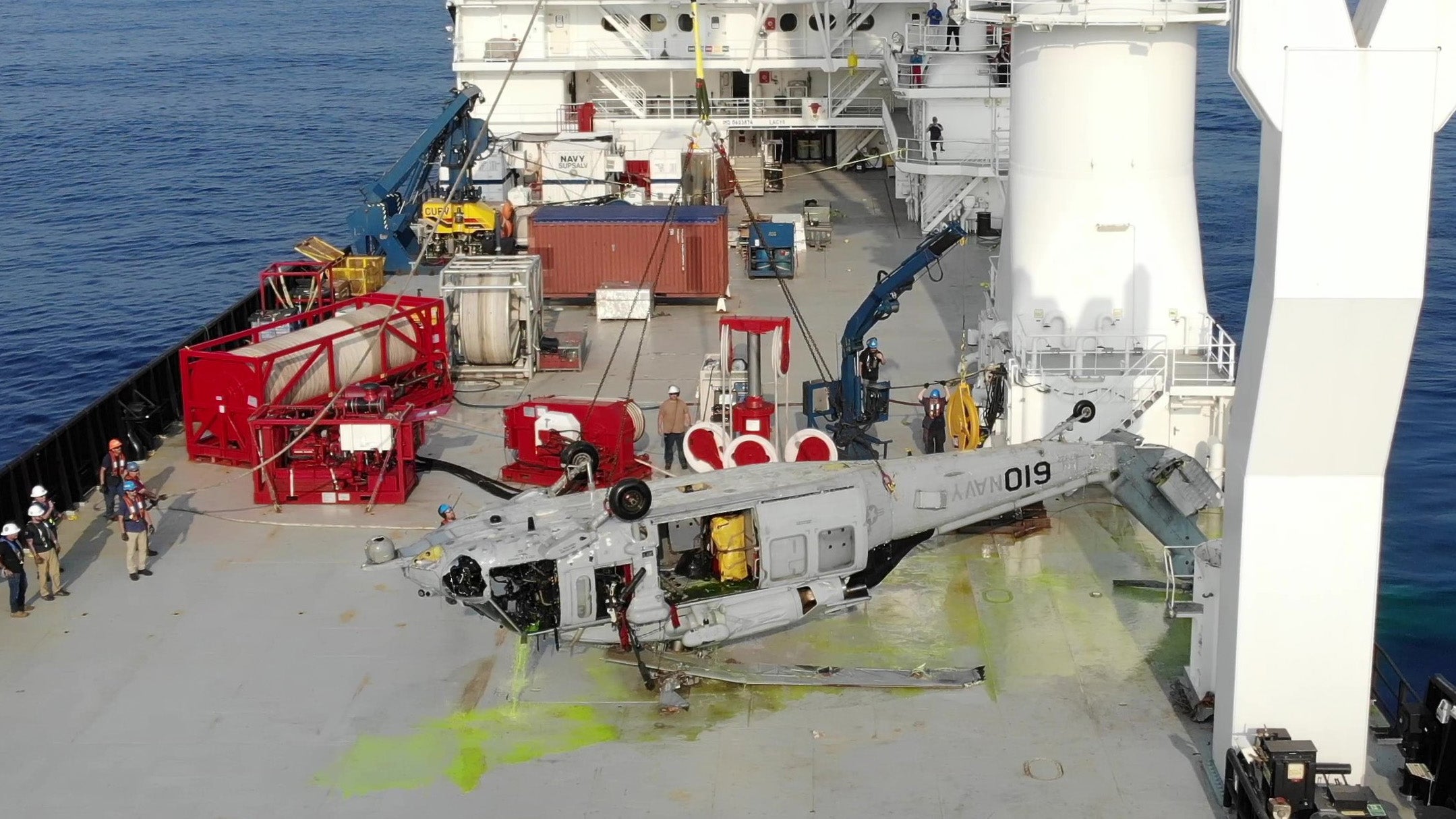The U.S. Navy has recovered an MH-60S Seahawk helicopter from the bottom of the sea off the coast of Okinawa, Japan, from a depth of 19,075 feet. The salvage effort, according to the Navy, sets a new record for aircraft recovery by the service’s deepwater recovery specialists.
While the MH-60S was retrieved from the Pacific Ocean last week, details of the impressive feat were revealed last night by Naval Sea Systems Command (NAVSEA), whose Supervisor of Salvage and Diving (SUPSALV) was responsible for bringing up the helicopter, which emerged looking to be in surprisingly good condition.

The Seahawk, operated by Helicopter Sea Combat Squadron 12 (HSC-12), the “Golden Falcons,” had crashed into the Philippine Sea 92 nautical miles east of Okinawa on January 25 last year. At the time, the helicopter was conducting operations from the amphibious command ship USS Blue Ridge (LCC-19).
No lives were lost in the accident, the five crew members managing to escape the MH-60S before it sank. The crew members were rescued by U.S. and Japanese forces. Two were taken back to the Blue Ridge by another Navy MH-60S from the ship and the other three flown by a Japan Air Self-Defense Force UH-60J helicopter to Naval Hospital Okinawa for evaluation.
The MH-60S is the Navy’s multirole variant of the Seahawk family and is responsible for a variety of missions largely centered around the utility mission-set. These include vertical replenishment, general logistics, search and rescue/combat search and rescue, special warfare support, and anti-surface warfare, among others.

Last spring, U.S. Pacific Command Fleet requested that SUPSALV find the sunken helicopter and then document whatever was left of it using side-scan sonar and photography.
This January, SUPSALV returned to the site on the orders of the Navy Safety Center. The team brought with them a 6,400-pound Cable-controlled Undersea Recovery Vehicle, CURV-21. This is a specialized deepwater remotely operated vehicle, which can undertake salvage operations down to a depth of 20,000 feet — the edge of the hadal zone, the deepest part of our oceans.
After embarking on a contractor-operated salvage vessel in Guam, SUPSALV readied the CURV and began a five-day transit to the location of the helicopter. Recovery operations began on March 17 and the following day the MH-60S was brought to the surface and loaded aboard the contractor’s vessel.
The Seahawk will now be taken back to Fleet Activities Yokosuka, Japan, from where it will be offloaded for transport back to the United States.
Once there, the airframe will be carefully examined by accident investigators to try and determine what went wrong in the first place.
What will happen to the helicopter after that is unclear, but it is in surprisingly good shape considering its water landing and time spent at the bottom of the ocean, under the rigors of immense pressure.

Securing potentially sensitive U.S. military hardware has long been a priority mission for the deep-diving salvage teams. It was a predecessor of CURV-21 that successfully raised a Mk 28 hydrogen bomb after the Palomares incident in 1966 when an Air Force B-52 bomber collided with a KC-135 tanker over the Mediterranean Sea. CURV-1 raised the 1.45-megaton bomb from a depth of 2,900 feet.

In 1976, the U.S. Navy nuclear research submarine NR-1 located and recovered a live AIM-54 Phoenix air-to-air missile in the North Atlantic off the coast of Scotland, preventing it from falling into Soviet hands.
It is unlikely, however, that the MH-60S would fit into the same category of classified military hardware. After all, the “Sierra” is mainly a utility platform, in contrast to its stablemate, the MH-60R, that carries comprehensive mission equipment for its anti-submarine warfare role. Still, there are sensitive technologies onboard.
More important, though, than the recovery of the Seahawk itself, was the opportunity for SUPSALV to demonstrate how quickly it can recover items from some of the deepest parts of the world’s oceans rapidly, should the need arise. Deep ocean search and recovery capabilities are critical for rescuing stricken submariners, for example, as well as bits of hardware.

The ability to recover things from the seabed also points to the potential to conduct intelligence-gathering operations, like the famous salvage of a portion of the Soviet Golf II class ballistic missile submarine K-129 from the bottom of the Pacific Ocean in the 1970s. For that operation, the Central Intelligence Agency employed the Hughes Glomar Explorer recovery ship.
In the recent past, The War Zone
examined the possibility of the U.S. recovering a batch of advanced Russian-made surface-to-air missiles, that seem to have been lost overboard from a container vessel.
In dragging up this helicopter from an unprecedented depth, the Navy at large has shown that it’s still very much up to the challenge of seriously demanding deep-sea salvage operations.
Contact the author: thomas@thedrive.com
